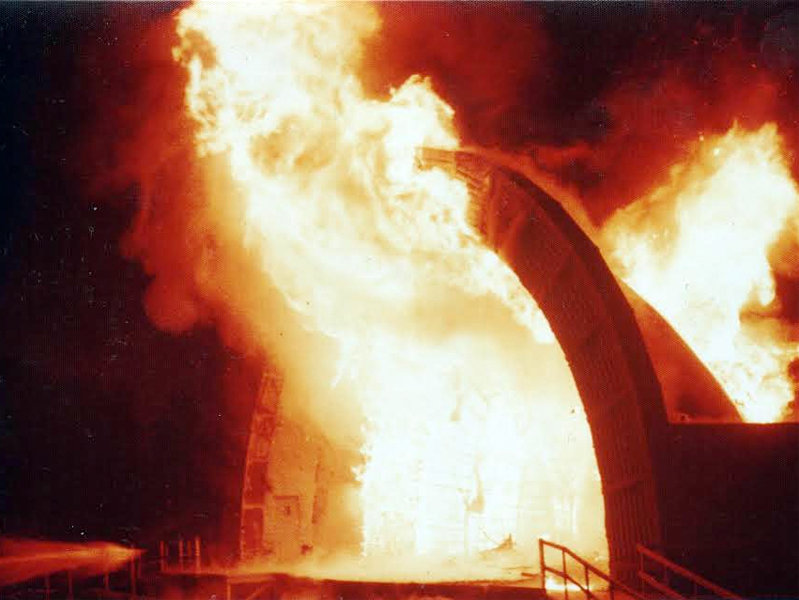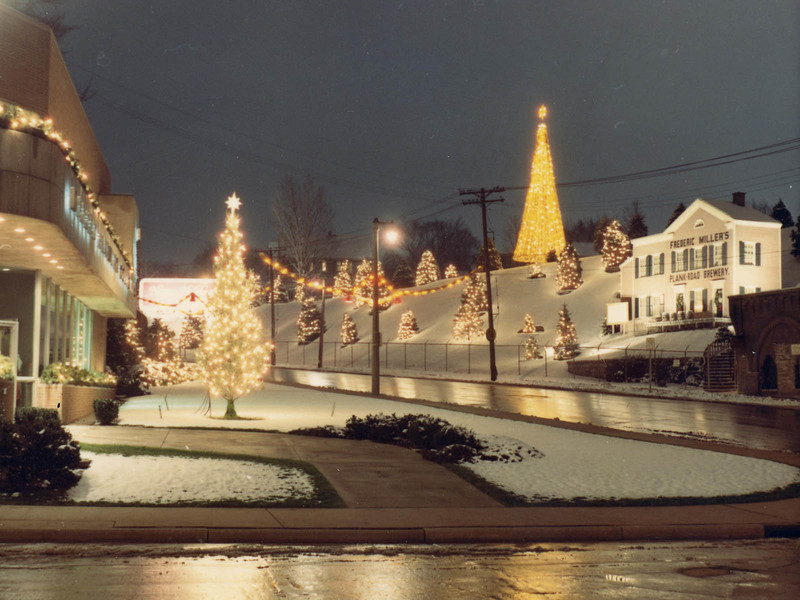It took a village to build the cream city brick Trinity Evangelical Lutheran Church, N. 9th St., in 1847 and the same is true today as the church continues to rebuild after a 2018 fire that nearly brought its life to an end.
A variety of teams of contractors, restorers and craftspeople have been working for the past four years to bring back the Gothic church, designed by architect Frederick Velguth, that lords over one of the highest spots in Milwaukee.
As we saw in May, the church has created a worship space in the undercroft after having spent the previous years in borrowed space or holding services upstairs in a narrow corridor, and much of the woodwork you see in that space – the railing, the altar, the lecterns – are the work of Ben Zuehlsdorf and his team at Zuehlsdorf Woodworks.
Zuehlsdorf and his colleagues – Scott Richter, Dan Barbian, Dan Ripley, Pete Schassler and Darrel Peterson – work out of an unassuming space in what looks like an old auto repair shop tucked away between houses on a West Allis side street.
But the work going on inside is anything but unimpressive.
Stepping in, one is immediately met with all manner of pieces of the woodwork from Trinity: large and small in an incredible variety of shapes. All of it the handiwork of woodworkers in the mid-19th century, and in a variety of conditions as expansive as the mix of forms.
Most of the pieces arrived in a jumble, having been damaged by a brutal combination of fire and high-pressure water, says Zuehlsdorf.
“They came here and buckets, in pieces like this, charred and in quite a bit of damage,” he says as we look at the spines of the top of Trinity’s pulpit, one of its most beloved internal features, and shelves lined with the many pieces that decorate it.
“They had already done (the bucketing). That was down in their storage location and we brought them back here and the guys got these cleaned up.”
But that was merely the first step in a long process.
Cleaning was sufficient for some pieces. But more were damaged and needed repairs, too. Still others needed some facets to be recreated. In some cases, Zuehlsdorf has had to recreate pieces.
“We create a form based upon their original, and then put the pieces back together,” says Zuehlsdorf, who notes that some decorative elements were molded plaster instead of wood. Those pieces are being recreated on CNC machines from an industrial foam that is commonly used for this sort of work because it is dense and extremely stable.
In addition to the pulpit, Zuehlsdorf Woodworks is restoring the pulpit, altar and the large reredos altar screen. It has already restored and returned the lectern, which is now in the undercroft at the church.
They will also work on the lower part of the pulpit and the altar rail.
“The pulpit got a lot of the damage coming down,” says Zuehlsdorf. “The lectern was in really bad shape and we had to recreate some parts, but fortunately, when they did the cleanup, they did a great job at keeping everything, and we were able to replace a few (things), but a lot was there. So we could at least, if there was one left side and no right, we could at least duplicate it.”
The main chunk of woodwork that will not be saved was in the form of the pews.
“They had probably, I want to say 20 pews that they had pulled out that were still somewhat okay,” says Zuehlsdorf, “but they were in really rough shape. And when you debate how long it takes to restore one of those, versus you're going to have to remake all (the rest) of them anyway. You just end up doing them (all) at the same time.”
However, those pews were not discarded and their essence will also continue to live on at Trinity; in fact some of it is already back in use at the church.
“They were kind enough to give us the material,” says Zuehlsdorf. “We took the pews back, we broke them down in the parts, and then the altar and the lectern in the basement, the boxes on them is new, but all of the intricate carvings were reclaimed from those pews.
“My goal is to use as much of the original material as possible, and to carry that on. I used a lot of it on the altar, and once you get through the nails and you get through the damage and that type of thing, (the amount of useful wood) is reduced considerably. But most of that has been done; it has been used up.”
Some of the small leftover pieces will be used to make crucifixes that can be sold to raise money for the ongoing fundraising effort to restore the church, which you can read about here.
“We pretty much went through those pews, complete,” says Zuehlsdorf. “That gave us the ability to make those, so one way or another 80 percent of the (pews) is going to get used.”
But yeah, there will be some new stuff and we pretty much went through those pews, complete.
The most striking object in the workshop at the moment is the reredos with its three arches, finials and intricate detail work.
Zuehlsdorf and his team used chainlifts to life the massive structure and then loaded it on a trailer to bring it back to the workshop last summer.
“This was all standing, for the most part, in the chancel,” he says as he stand beside it, just the top part of it taller than either of use. Nearby stand posts that are nearly seven feet tall.
“This section goes on top of those columns,” Zuehlsdorf says. “And then those columns sit on top of the bottom reredos and altar, which we still have tucked away. We haven't started stripping that stuff yet. We have to work with space (available) and that type of thing.”
The work here is time- and labor-intensive. Each piece seems to sit atop another on this wedding cake-like structure and some of those pieces were created by artisans from many smaller pieces. In some cases those objects had crumbled into their component parts, requiring team members to reassemble them like a three-dimensional puzzle from a pile of seemingly random shapes.
This area of the shop is extremely interesting and offers a study in contrasts because some parts have been sanded, bleached, repaired, reassembled and finished, and stand just feet away from still-untouched wood that’s still charred from the blaze.
It’s a labor of love, says Zuehlsdorf, who has been doing this work for about a decade full-time after having worked for some years with his father on woodworking projects.
“My dad was a retired principal, but he had done woodworking his whole life and he retired early, and kinda took that on,” he says. ”And then when the economy went south and I lost my job in 2009, I kind of joined him and we did some things together. So, it's kind of where it all came from.
“But as far as getting the relationship with Trinity, my childhood church, my father's childhood church, was Bethlehem Lutheran. So, because that's the daughter church of Trinity and all of that story.
“We were there the day after the fire, the pastor and I from (Zuehlsdorf’s current church) Mount Olive, we came to visit, and then another pastor from Elm Grove actually asked me to make a crucifix out of one of the beams. So I made one of those and then he asked to make another one.”
That work caught the attention of Trinity, who reached out to what it saw as a family member thanks to the Bethlehem connection. Plus, he’s done a communion rail, modesty panel and other work at Mount Olive, as well as a reredos and altar extensions in the lower chapel at the Basilica of St. Josaphat.
“They're real careful,” Zuehlsdorf says. “It seems that they want people involved that care about the project. And that's exactly where I sit.”
Most of the woodwork arrived at Zuehlsdorf Woodworks around January (some earlier), and it will probably be returned after about a year’s work.
“This is probably going to have to wait until they're ready for us,” Zuehlsdorf says. “So this stuff will probably go in right when they're done with painting and all of that type of thing. It's hard to say (when). Originally it was December, but I think we're probably January, February.”
Zuehlsdorf has loved the work that is (hopefully) a once-in-a-lifetime opportunity for a craftsman, especially one with a deep connection to Trinity (his grandmother was church secretary at Bethlehem for more than a half-century, his father was principal at the school, where his mother taught and where he and his siblings attended).
“It's an honor to do it and I'm grateful for it,” he says. “It's been a fun process, too. Everything I’ve learned in 20 years will come together on this project.”
Born in Brooklyn, N.Y., where he lived until he was 17, Bobby received his BA-Mass Communications from UWM in 1989 and has lived in Walker's Point, Bay View, Enderis Park, South Milwaukee and on the East Side.
He has published three non-fiction books in Italy – including one about an event in Milwaukee history, which was published in the U.S. in autumn 2010. Four more books, all about Milwaukee, have been published by The History Press.
With his most recent band, The Yell Leaders, Bobby released four LPs and had a songs featured in episodes of TV's "Party of Five" and "Dawson's Creek," and films in Japan, South America and the U.S. The Yell Leaders were named the best unsigned band in their region by VH-1 as part of its Rock Across America 1998 Tour. Most recently, the band contributed tracks to a UK vinyl/CD tribute to the Redskins and collaborated on a track with Italian novelist Enrico Remmert.
He's produced three installments of the "OMCD" series of local music compilations for OnMilwaukee.com and in 2007 produced a CD of Italian music and poetry.
In 2005, he was awarded the City of Asti's (Italy) Journalism Prize for his work focusing on that area. He has also won awards from the Milwaukee Press Club.
He has be heard on 88Nine Radio Milwaukee talking about his "Urban Spelunking" series of stories, in that station's most popular podcast.







